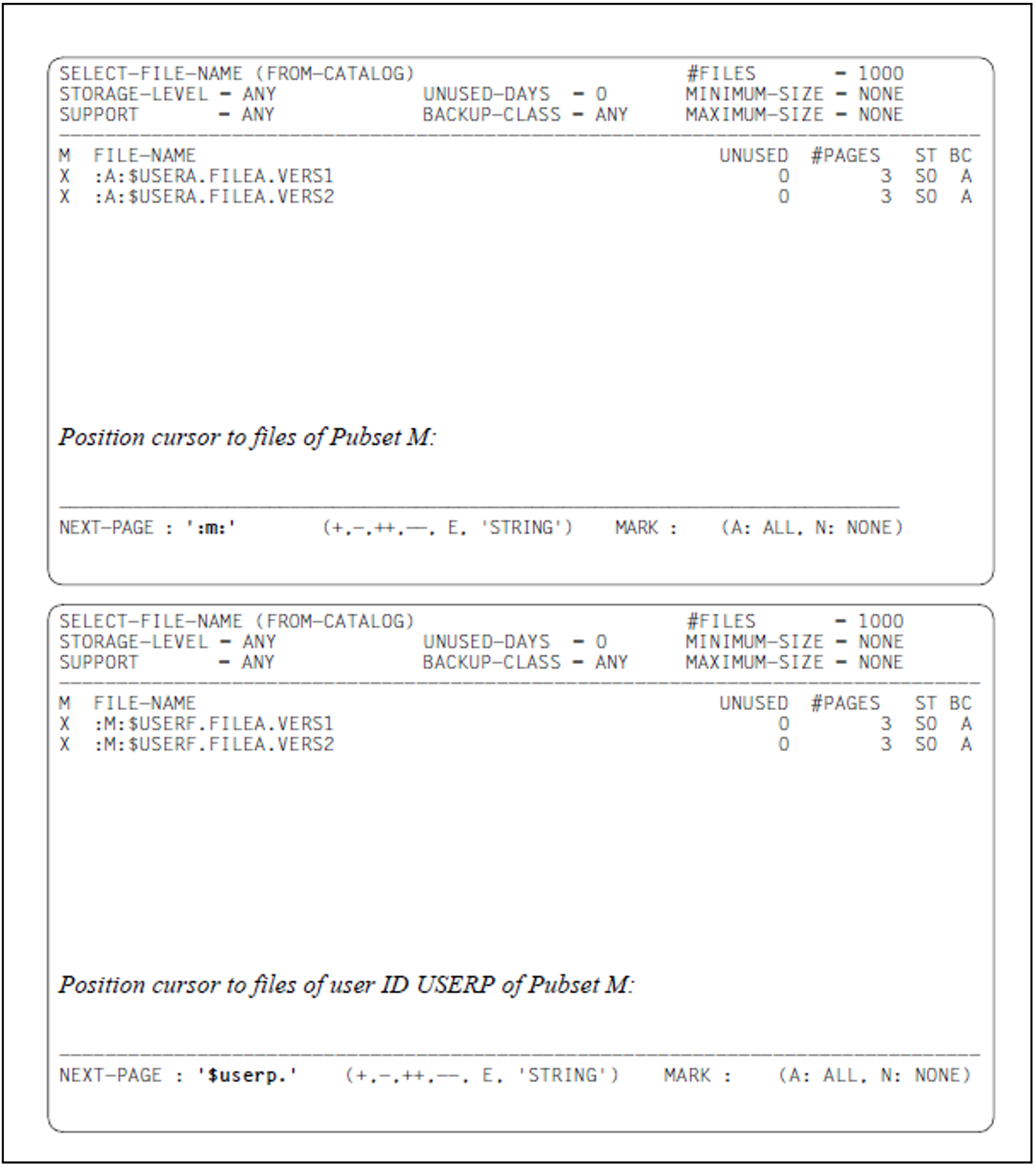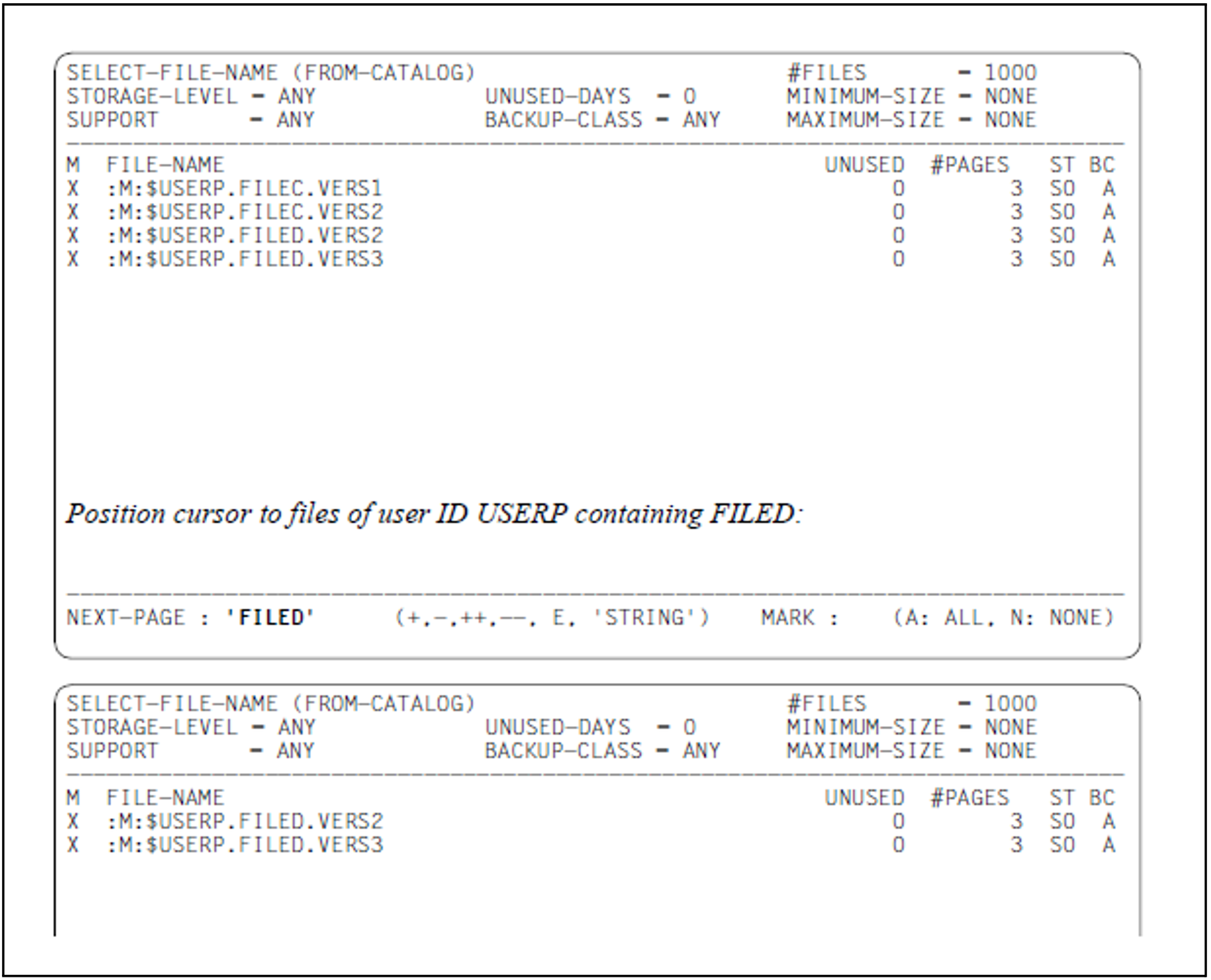File selection in a dialog is available only for BS2000 files and only at a block-oriented data display terminal (e.g. 9750).
In the case of both SELECT-FILE-NAMES and also some action statements, a further selection can be made in the list which was generated according to the criteria specified: the files in the list are presented in screen masks when DIALOG-FILE-SELECT=*YES. The files can be highlighted to select or exclude them individually or by the screenful.
Example
Screen mask display for DIALOG-FILE-SELECT
SELECT-FILE-NAME (FROM-CATALOG) #FILES = 27 STORAGE-LEVEL = ANY UNUSED-DAYS = 7 MINIMUM-SIZE = NONE SUPPORT = ANY BACKUP-CLASS = ANY MAXIMUM-SIZE = NONE -------------------------------------------------------------------------------- M FILE-NAME UNUSED #PAGES ST BC X :T:$TESTUSER.FILE.TEST.1 8 31 S0 A X :T:$TESTUSER.FILE.TEST.3 12 43 S0 A X :T:$TESTUSER.LIB.TEST.2 13 523 S0 A X :T:$TESTUSER.LIB.TEST.5 7 267 S0 A X :T:$TESTUSER.LIB.TEST.7 23 1290 S0 A X :T:$TESTUSER.LIB.TEST.10 9 101 S0 A X :T:$TESTUSER.PROC.TEST.3 7 7 S0 A X :T:$TESTUSER.PROC.TEST.6 21 3 S0 A X :T:$TESTUSER.PROG.TEST.1 17 198 S0 A X :T:$TESTUSER.PROG.TEST.2 11 353 S0 A X :T:$TESTUSER.PROG.TEST.2 11 353 S0 A X :T:$TESTUSER.SYNTAX.TEST.GROUP 15 333 S0 A X :T:$TESTUSER.SYNTAX.TEST.USER 15 145 S0 A X :T:$TESTUSER.TEST.1 12 232 S0 A X :T:$TESTUSER.TEST.12 37 87 S0 A X :T:$TESTUSER.TEST.14 34 102 S0 A -------------------------------------------------------------------------------- NEXT-PAGE : __ (+, -, ++, --, E) MARK : (A: ALL, N: NONE)
Key:
Column | Meaning |
M | Mark column (character = file is selected, blank = file is not selected) |
FILE-NAME | Path name of the file |
UNUSED | Number of days since the file was last accessed |
#PAGES | File size in PAM pages (FILE-SIZE) |
ST | Storage level at which the file is located |
BC | File backup class |
Selection by marking
A file is regarded as selected if it is marked in the mask by a character in the mark column (M column). It is regarded as exempted if it is not marked (blank in the mark column).
When calling DIALOG-FILE-SELECT, files are listed in FHS masks but not selected.
By entering “A” in the MARK field in the bottom line all files are selected, even if they are not displayed on the screen.
As an alternative, “N” may be entered in the MARK field. This excludes all files from selection, i.e. all files displayed in the mask are marked with a blank in the mark column. The desired files can then be marked with any character other than a blank (positive selection). You can reset all the entries you have made thus far by entering “N” or “A”.
The contents of the screen when you terminate the function by entering “E” in the NEXT-PAGE field determine which files are selected.
Positioning by means of a search string
Users can scroll up and down within the mask by entering “ + ”, “ – ”, etc. Alternatively, a search string of up to 10 characters enclosed in single quotes can be entered in the NEXT-PAGE field in order to position to specific files.
The search string entered as a positioning criterion may be either a fully or partially qualified path name without wildcards, or part of a path name (catalog ID and/or user ID and/or file name). Any leading parts of the path name which the user omits are adopted from the corresponding parts of the path name of the first file displayed in the current mask. HSMS appends a wildcard to the search string to ensure that longer path names will also be found. If the specified (or extended) path name does not exist, the cursor is moved to the next file name in the sorting sequence.
For example, specification of a catalog ID positions the cursor to the first file with that catalog ID or to the next existing catalog ID in the sorting sequence.
Specification of a user ID positions the cursor to a file which has that user ID and the catalog ID of the first file displayed in the current mask. The user ID must be entered with “$” followed by a period. Otherwise, HSMS will perform a secondary read operation to the default user ID.
The cursor can be positioned to individual files by entering the first characters of their name (without the period). This initiates a search for a file that has both the specified file name and the user ID and catalog ID of the first file displayed.
Example
The cursor is to be positioned to a file beginning with the string “FILED”, belonging to the user USERP and residing on pubset M. This is carried out in several stages.
Even though the search string is short, the cursor can be positioned to the desired file by successively entering the catalog ID, the user ID and parts of the name.


